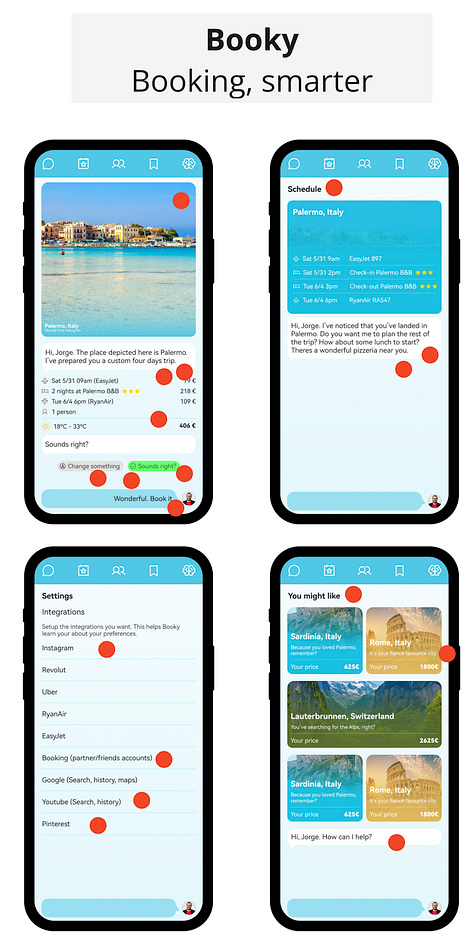From Concepts to Consensus: How We Chose Booky as Our AI Concierge
Our design sprint reached its crucial decision point as we shared concepts, voted democratically, and collectively chose Booky—our AI concierge solution for cultural discovery.
With our solution sketches complete, we entered the most critical phase of our design sprint process—the decision-making stage where individual concepts transform into a unified team vision. This post documents our structured approach to concept sharing, evaluation, and selection, culminating in the birth of Booky, our AI-powered cultural concierge.
The Structured Decision-Making Process
Following established design sprint methodology, we implemented a five-step decision process that ensures democratic participation while maintaining focus on our strategic objectives. This systematic approach prevents the common pitfall of "designing by committee" while ensuring every team member's insights contribute to the final decision.
Step 1: The Art Museum - Revealing Our Concepts
We began by transforming our workspace into an "art museum," posting all solution sketches on the walls for team-wide review. This visual display allowed every team member to see the full range of concepts that emerged from our individual sketching sessions.
Each concept was presented anonymously, allowing ideas to be evaluated on merit rather than authorship. This approach follows the principle that the best ideas should win regardless of who generated them, a core tenet of effective design sprint facilitation.



Step 2: Heat Map Voting - Identifying Popular Elements
The next phase involved heat map voting, where each team member received a sheet of colored dots to mark interesting elements across all concepts. This silent voting process lasted 15 minutes and allowed participants to:
Identify compelling features across multiple concepts
Highlight innovative approaches to our Sprint Questions
Surface unexpected solution elements that resonated with the team
The heat map voting revealed fascinating patterns in our team's preferences, with certain interaction models and AI integration approaches receiving significantly more attention than others. This visual feedback helped us understand which elements were most compelling to our diverse team perspectives.
Step 3: Speed Critique - Understanding the Concepts
Following the heat map exercise, we conducted speed critiques where the facilitator presented each concept to the team, focusing on the elements that had received the most votes. This three-minute-per-concept review ensured that:
Everyone understood each concept's core value proposition
Key features and interactions were clearly explained
Questions about implementation details were addressed
The thinking behind each approach was made transparent
During this phase, we discovered that while our concepts addressed different aspects of our Sprint Questions, several shared common threads around conversational AI interfaces and contextual recommendation systems.
Step 4: Straw Poll Vote - Democratic Selection
The straw poll voting phase required each team member (except the designated Decider) to choose their preferred concept using a large green dot. This binding vote was conducted simultaneously to prevent influence bias, with each participant placing their dot and briefly explaining their choice.
Key selection criteria that emerged:
Feasibility within our development timeline
Alignment with our 20% conversion rate improvement goal
Potential to address all three Sprint Questions effectively
Scalability for Booking.com's global user base
The straw poll results showed a clear preference for AI-powered conversational interfaces over traditional menu-driven booking systems, validating our hypothesis about the importance of natural language interaction in cultural discovery.
Step 5: Supervote - The Final Decision
The culminating moment came when our designated Decider reviewed all concepts and team feedback before making the final selection. Armed with two green-starred dots, the Decider chose to focus development resources on the AI concierge concept that would become Booky.
The Power of Structured Decision-Making
Our experience with the design sprint decision process demonstrates the value of structured approaches to complex product decisions. By combining democratic participation with expert judgment, we achieved both team alignment and strategic focus—essential ingredients for successful product development.
The Booky concept that emerged from this process represents more than just a product decision; it embodies our team's collective intelligence and shared commitment to transforming cultural discovery through thoughtful AI design.
Why Booky Emerged as Our Chosen Solution
The concept that became Booky stood out for several critical reasons:
Comprehensive Sprint Question Coverage
Booky directly addressed all three of our prioritized Sprint Questions:
Integration without Disruption: The AI concierge design allows cultural discovery to happen naturally within the existing Booking.com flow, appearing contextually after accommodation booking rather than competing for attention.
Daily Companion Potential: By designing Booky as a conversational AI that learns user preferences over time, we created a foundation for ongoing engagement beyond individual bookings.
Impulse Purchase Optimization: The AI's ability to surface timely, contextual opportunities creates natural moments for spontaneous cultural experience booking.
Technical Feasibility Assessment
Our team evaluation revealed that the AI concierge approach balanced innovation with practical implementation considerations:
Leverages existing AI infrastructure at Booking.com
Builds on established conversational interface patterns familiar to users
Allows for iterative development starting with basic recommendation capabilities
Provides clear expansion paths for advanced features like group coordination and social integration
Market Differentiation Opportunity
Booky's conversational AI approach creates meaningful differentiation in the cultural experience booking market, where most platforms rely on traditional search and filter interfaces. The AI concierge model addresses the "context gap" we identified in our earlier research—users need more than just basic information to make informed decisions about their cultural experiences.
What aspects of our decision-making process resonate most with your own experience in product development? We'd love to hear your thoughts on structured concept selection methods.
Remember: Booky is an academic project created for educational purposes and is not affiliated with or endorsed by Booking.com. All concepts and experiments shared here are part of a student exercise in digital product management.









